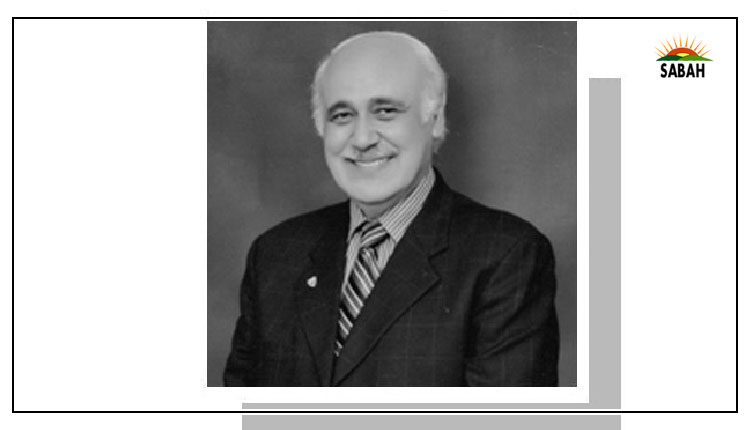Noblesse oblige۔۔۔F.S. Aijazuddin
SIR Charles Aitchison would have been so gratified. Two alumni from the college he founded in 1886 had a reunion on May 12 at the Supreme Court of Pakistan in Islamabad. They met with patrician courtesy, the junior greeting his senior with: Happy to see you!
The junior of the two now Supreme Court Chief Justice Umar Ata Bandial was included last year by Time magazine among its top 100 influential people in the world. Its citation described him as a polite and understated Chief Justice of Pakistan and antidote to the rising temperatures within a combustible country.
Recently, CJ Bandial headed the three-member bench that heard a petition by the once and future prime minister Imran Khan, who complained against his ham-handed arrest and detention by NAB. (Imran Khan joins five other prime ministers who have similarly enjoyed NABs uncivil hospitality). The bench decided in Imran Khans favour, granting him bail and release from NABs custody.
That decision spawned a hundred fresh friends among PTI supporters and a thousand fresh enemies among the PDM-led coalition government. Its leaders griped that they had never enjoyed such chamois-gloved treatment by previous benches. Instead of being accommodated in a police rest house (as Imran Khan was), they had to spend months in less salubrious lodgings.
That Imran Khan is lucky is beyond doubt.
That Imran Khan is lucky is beyond doubt. He has been Teflon-coated by fate. Success comes unbidden to him. He is the enfant terrible who to his admirers can never be terrible enough. He has a following that is loyal beyond persuasion, responds whenever he calls, and displays all the fervour of mindless militancy.
On May 9, (the day of Imran Khans arrest by NAB), a mob led, it appeared, by PTI stalwarts attacked the residence of the Corps Commander IV in Lahores hermetically sealed cantonment. Another crowd breached the gates of the seemingly impregnable GHQ in Rawalpindi.
Ordinarily, no one can enter any of Pakistans cantonment areas without passing through manned check-posts. The area around the corps commanders residence in Lahore has always been ultra-security conscious. So much so that even the windows in the commercial Mall of Lahore that overlooked the CCs compound were kept boarded permanently.
Every road that approaches the residence has obstacles to deter the unwelcome, and within its compound, at least 50 to 60 soldiers remain permanently on rota duty.
How could a crowd of several hundred reach it without being detected or stopped? Unless, that is, they were bussed in, within walking distance of the compound whose gates were left obligingly open for them to then vandalise the house and all its contents.
The CC IVs house once belonged to Quaid-i-Azam Mohammad Ali Jinnah. He acquired it in 1943. In January 1948, it was requisitioned by the Pakistan Army and has remained in its custody ever since. Jinnah House (as it was known) was one of three prime properties owned by the Quaid. This one in Lahore, and the other two in Karachi Flagstaff House (now a museum) and an office building on I.I. Chundrigar Road (now the head office of Standard Chartered Bank).
The mob which attacked Jinnah House Lahore could not have been expected to remember its association with the founder of our nation. Mobs rarely think before they act.
Too many Pakistanis (both in mufti and khaki), though, are disturbed at the ease with which that rabble could invade Jinnah House. Remember, it is located less than 30 kilometres from the Indian border at Wagah.
In 1965, the narrow strip of land between the Attari-Wagah border and Lahore city was the scene of a bitter battle, fought with desperate determination, at the cost of many lives. A memorial at Batapur to those shuhada marks the spot. On May 9, 2023, Lahore was attacked again by another enemy, this time from within.
Despite the denials by the military that the heads of senior officers have rolled, there is a justifiable concern amongst an unarmed public about its safety, and the security of our nuclear assets. Mercifully, they were not stored in CC IVs house. (Shades of the Ojhri camp disaster in 1988.)
These concerns are not expressed lightly. They are genuine, simmering in a population that has eaten grass these past 50 years as the price for national security.
A recent academic analysis has compared the populist policies espoused by M/s Imran Khan, Modi and Trump. It says their success lies in dividing their countries between the pure people and the corrupt elite. They employ fake news and propaganda to advance their agenda to any extent.
They have a common teacher: Hitler. He taught: The art of leadership consists in consolidating the attention of the people against a single adversary and taking care that nothing will split up that attention.
The writer is an author.
www.fsaijazuddin.pk
Courtesy Dawn, May 18th, 2023












